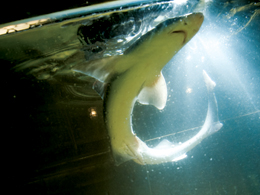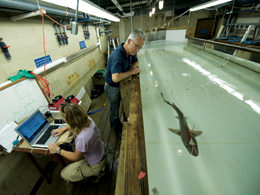Neuroscience
Following the Flow

The nostrils of a smooth dogfish shark are seen clearly, above, as it executes a tight left turn in search of food. Small pores midway between the eye and gill slit, below, form part of the shark’s flow detection system.

The fish tanks of the Boston University Marine Program laboratories gurgle in the background as Biology Professor Jelle Atema snaps open a large, black case to reveal RoboLobster—a foot-long, battery-powered tube on wheels that’s stuffed with sensors and processors. Atema helped create this device in the late 1990s to mimic the way lobsters track odors that help them find food and identify both rivals and mates. Unfortunately, RoboLobster was nowhere near as good as a real lobster in tracking an odor. The problem, Atema says, was that the swirls and eddies of odor plumes can get chaotic downstream from the source. Smelling alone was not enough, but it was all RoboLobster could do. Lobster brains, like those of many marine animals, need flow detection to properly find their way.
In recent years, Atema has been looking into how marine animals interpret the flow of their watery world, and how these systems work with other senses, such as olfaction and vision, to help them navigate through the depths and identify objects of interest. His findings could lead to increasingly autonomous biomimetic robots designed for any number of underwater chores—from finding the source of a pipeline leak to stalking enemy ships for the military.
“Sharks have very good eyes, but their importance only comes out after you eliminate the major sense—the lateral line.”
Most recently, Atema has focused on the shark’s lateral line, a system of canals under the skin near the animal’s head and along the length of its body that admit water through very fine pores and sense flow by detecting slight changes in water pressure. Atema and former BU biology grad student Jayne Gardiner, now a doctoral candidate at the University of South Florida, tested the ability of small sharks to swim to and strike a source of squid odor flowing down an eight-meter-long tank with a turbulence-causing brick just downstream of the source of squid juice. In some trials, they eliminated the sharks’ vision by testing them under infrared light, or they disabled the lateral line with an antibiotic. Sometimes, they impaired both sensory systems.
One result reinforced the notion that olfaction and flow detection are closely linked. The sharks were much more interested in the brick, a site of both odor and turbulence, than in the nonturbulent odor nozzle just upstream. Still, turbulence alone, without odor, was ignored. Plus, while light or dark conditions made no difference in the ability of sharks with an intact lateral line to find the odor target, vision became very important to sharks with disabled lateral lines. In the light, these disabled sharks had about 70 percent the success rate of unimpaired animals in finding the brick. In the dark, the success rate of these sharks, left with just their sense of smell, plummeted to 30 percent—and despite their intact noses, these animals could not find the odor source at all.

By delivering small puffs of odor to each nostril via a stereo headset attached to the shark, biologist Jelle Atema can determine which features of an odor plume are most important to the shark’s navigation. Here, graduate student Jayne Gardiner programs the next experiment.
“Sharks have very good eyes,” says Atema. “But their importance in this task only comes out after you eliminate the major sense—the lateral line.” He plans to use these findings as a basis for an upgraded biomimetic aquatic robot—whether it be a RoboLobster or a RoboShark—using multiple sensory information channels.
Of course, he says, no matter how well you mimic an animal’s sensory systems, the result will always pale in comparison to the complexity of the real thing, a fact that hit home with RoboLobster. After all, he says, “The joke is that this is the one lobster we don’t eat after research.”